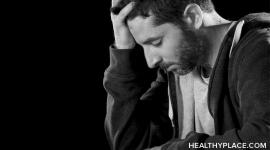Major Depression (MDD) Symptoms, Causes, Treatments
Major depressive disorder (MDD) is a very real illness that can cause significant suffering in many life areas including relationships, work, school, participation in daily activities, health, thought patterns, and emotions. In its Diagnostic and Statistical Manual of Mental Disorders, Fifth Edition (DSM-5), the American Psychiatric Association describes it as the “classic condition” of all depressive disorders. MDD is often what people mean when they use the word “depression.” What, precisely, is meant by this heavy word? Read on to explore what MDD truly is, the epitome of major depressive disorders.
Knowing what MDD is not can help clarify a major depressive disorder definition. People use the word “depressed” loosely and often. Sometimes, it refers to negative feelings but doesn’t truly define MDD. This isn’t a period of sadness or feeling blue. It also isn’t exclusively a response to an event like a break-up, loss of a job, or other temporary, albeit difficult, hardship. The DSM-5 specifies that major depressive disorder is not the same as grief or bereavement.
This is an illness that has mental and physical components, in part because of hormones and neurotransmitter activity and physical changes in the brain that affect the mind and body alike ("What Are the Physical Symptoms of Depression?"). Because it’s so all-encompassing, MDD can be devastating.
What Makes This Major Depressive Disorder? MDD Symptoms
Major depressive disorder is a type of mood disorder that, like other such disorders, occurs in episodes. People with MDD have periods of normal mood that are punctuated by bouts of serious depression. To be diagnosed with major depressive disorder, episodes must last two full weeks or longer (in major depressive disorder, the episodes typically last months or even years) and involve distinct changes in thinking, feeling, and behaving.
Beyond these criteria, MDD encompasses many possible symptoms. To be diagnosed with major depressive disorder, someone must experience at least five of the following symptoms almost all day, nearly every day, for at least two weeks. One MDD symptom must be the first and/or the second in the list:
- Depressed mood, such as sad or empty
- Loss of interest in activities and people
- Weight loss or gain without trying
- Sleeping too much or too little
- Overwhelming fatigue and loss of energy
- Sense of worthlessness
- Struggles with concentrating and decision-making
- Recurrent thoughts of death or a specific suicide plan
Major depression is also characterized by a pessimistic outlook. Chronic pessimism can create a sense of despair that can be crushing and further intensify the above symptoms.
One difference between MDD and the subjective feeling of being depressed is the degree to which depression impacts someone’s life. A major depressive disorder definition includes the criteria that the illness must cause “clinically significant distress or impairment in social, occupational, or other important areas of functioning. (American Psychiatric Association, 2013). Major depressive disorder isn’t a little annoyance or inconvenience. It’s an illness that lowers someone’s quality of life.

What Is It Like Living with Major Depression?
Major depression affects the entire person: the way they think (cognitive problems), emotions they feel or do not feel, things they do or do not do, and physical sensations. Together, these can make someone feel as though they’re watching their life from a foggy distance and they’re very sad to be just watching; however, they don’t know how to close the distance—and they’re not sure they really want to. MDD is confusing, frustrating, and crushing.
People who have lived with major depression describe problems like:
- Being easily distracted at work or with family
- Lack of motivation from feeling discouraged and hopeless
- Numbness or lack of any feelings at all
- Excessive or even delusional guilt that interferes in healthy relationships
- Frustration over the amount of time and effort even simple tasks take
- Irritability, frustration, and anger that lead to outbursts
- Constant aches and pains, cramps, digestive troubles, and/or headaches that don’t respond to pain killers or other medication and whose cause can’t be identified
- A belief that others would be better off without them and/or a desire to end suffering because the future seems full of more despair. (Help is available for anyone having suicidal thoughts. Get round-the-clock help from The National Suicide Prevention Lifeline at 1-800-273-8255 or https://suicidepreventionlifeline.org/.)
It’s important to remember that everyone is different. No two people with MDD have the exact same symptoms and experiences. Also, the level of impairment someone may experience falls on a spectrum ranging from very mild (it goes unnoticed because the person can hide their symptoms) to so severe it can be classified as a disability ("Is Depression a Disability? Can You Get Accommodations?").
Despite how it may seem to someone living with major depressive disorder, this illness is highly treatable. Depression treatment options include medication, therapy, learning coping skills, and sometimes electroconvulsive therapy (ECT). How your MDD is treated is up to you, your doctor, and/or your therapist. You can overcome major depressive disorder and live fully.
APA Reference
Tracy, N.
(2022, January 3). Major Depression (MDD) Symptoms, Causes, Treatments, HealthyPlace. Retrieved
on 2024, November 20 from https://www.healthyplace.com/depression/major-depression/major-depression-major-depressive-disorder-symptoms-causes-treatments


